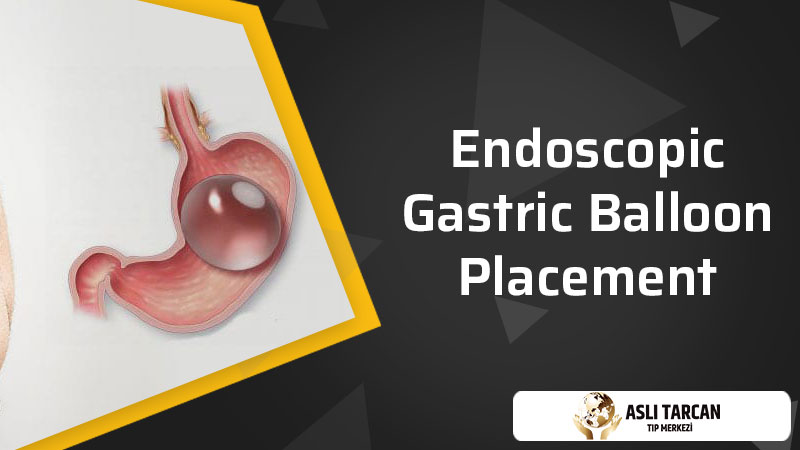Endoscopic gastric balloon placement; obesity is a health concern that exists in the background of most of the extremely frequent and common ailments, despite the fact that some of us disregard it. Intervention in this condition is critical, and it is feasible to profit from contemporary medicine’s superior equipment in doing so. The instruments employed in the treatment of obesity are known as obesity surgery, weight loss surgery, or stomach reduction surgery. The gastric balloon, also known by its medical name Intragastric balloon, is one of these surgical applications and one of the most successful kinds of the current generation.
Endoscopic Gastric Balloon Placement
Gastric balloon surgery is a low-complication procedure that helps patients to lose weight efficiently in a short period of time, and studies have shown that patients lose weight. Obesity can lead to a variety of health issues, including cancer. The available statistics and clinical trials suggest that combating obesity rather than the illnesses induced by fat is a far more effective way to tackle the problem at its source. It is important to pick all necessary procedures for the management of this health condition since it is well acknowledged that people face severe health risks at the level at which bariatric surgery is required.
Of course, the physician determines which application will be made and which protocols are favored in light of medical protocols. A gastric balloon is a synthetic implant that is fashion like a balloon. Endoscopically lower into the stomach, this device can be load with liquid or air. This application, which works by lowering the stomach’s capacity by creating an indigestible gap rather than by reducing its volume, can be used for six months or a year and is withdrawn the same way it was put at the conclusion of the term.
The stomach balloon make of a synthetic (silicone) material that is extremely strong. There are two versions of this vehicle: one with liquid and one with air. Both types have their advantages and disadvantages. Balloons with a capacity of around 700cc that may change in intervals stay in the stomach for a year without causing any problems. There may be leaking in rare cases, in which case the problem resolve by endoscopic balloon removal.
How Does Endoscopic Gastric Balloon Placement Make You Lose Weight?
The gastric balloon is not a weight-loss medication or an energy-burning gadget. This gadget lowers the stomach’s nutrition storage capacity, preventing the user from eating too much food. Because there are no incisions or other requirements in the stomach, the individual may return to his usual life in a short period of time, allowing him to quickly attain the calorie-burning level necessary by his everyday life. Unlike other weight reduction operations, however, the gastric balloon is a type of treatment that allows for more activity. As a result, because the individual may participate in sports, the weight reduction process might accelerate depending on the scenario.
However, it’s impossible to discuss a natural weakening process following gastric balloon surgery. Even if the amount of food ingested at one time reduces, if the overall daily calorie intake does not lower and the types of food consumed are not appropriate for the physician’s diet, the outcome may be less than ideal. Following the treatment, the individual must perform regular workouts and consume suitable foods at appropriate meals. Only in this manner, as in other bariatric surgery surgeries, would success be achievable.
When Did Endoscopic Gastric Balloon Placement Invent?
The gastric balloon is a weight-loss device that authorizes by the American Food Administration (FDA) in 1985. This application began to use as a medical application in 1987 and 1988, and it exposes to the discussion in 1992 owing to some of its adverse effects. After its development processes finish in 2015, the technique acquire a license from the American Medical Devices and Drug Administration with its present application form, and it now employs a medical protocol in virtually every country on the planet. In reality, France, a European country, is the one that produces the most balloons.
Prime Age For The Endoscopic Gastric Balloon Placement
Adults can benefit from gastric balloon surgery. The age range is 18 to 60 years old. However, depending on the circumstances, the age restriction might extend from 16 to 75. As indicated under the categories of who should have a gastric balloon surgery and who should not, appropriate adjustments in age groups can make, taking into account the condition of obesity and its impact on the individual.
Bariatric surgery does not typically recommend for children under the age of 18. Even diets for children of developmental age should administer with caution. Although executing such surgery might regard as a danger. However, if obesity becomes a bigger danger than other hazards, the application’s age limit can reduce somewhat by doing comprehensive analyses.
Because nutrition is so essential at advanced ages. Extending the age limit is a decision that may take based on the results of the research. Certain stretches may be achievable if the doctor certifies their appropriateness and no additional factors are present.
Risks Of Endoscopic Gastric Balloon Placement
The gastric balloon is more of an endoscopic application than a surgery. It doesn’t consider a full-fledged surgical procedure. As a result, the hazards are likewise modest and infrequent. When performed by a physician who is an expert in his area and has extensive experience with gastric balloon insertion and removal. The risk reduces by the same percentage. The use of a gastric balloon is a quick procedure that takes around 15-20 minutes on average. Gastric balloons filled with blue liquid and place into the stomach via video endoscopy. To aid in the battle against obesity. The dangers and consequences are quite uncommon.
In all procedures, there is a danger of bleeding. It is a problem induce by unskilled surgeons during the installation or removal of a gastric balloon. Its occurrence is quite unusual. Even if the procedure is just temporary, the gastric balloons should place gently. Until they drop into the stomach and depart from there. A rapid movement may induce bleeding in the digestive tract until it reaches or leaves. Additional actions or treatments should use to stop bleeding.
Endoscopic Gastric Balloon Placement: Will It Help Me Lose Weight?
Endoscopic gastric balloon placement is a safe and minimally invasive procedure involving inserting a saline-filled balloon into the stomach. The gastric balloon placement helps reduce hunger and caloric intake, making it an effective weight loss option. Through endoscopic gastric balloon placement, there is potential for long-term lifestyle changes to help individuals maintain their weight loss goals. With close monitoring by a health care specialist, individuals can benefit from continued motivation and guidance along their weight loss journey to lose excess weight, improve overall health, and reduce the risk of obesity-related diseases.

Individuals must follow their doctor’s post-procedure instructions and lifestyle changes to achieve a successful weight loss journey. Taking part in exercise and a healthy diet can ensure the best outcome. Additionally, patients may be prescribed medication or dietary supplements to help them reach their desired results. Patients may also have regular checkups with their doctor to ensure that the balloon is functioning correctly and that they are on track with their weight-loss goals.

With these tools in place, endoscopic gastric balloon placement can be effective for sustained weight loss success. Overall, endoscopic gastric balloon placement is an excellent option for anyone looking to lose weight safely and minimally invasively.




